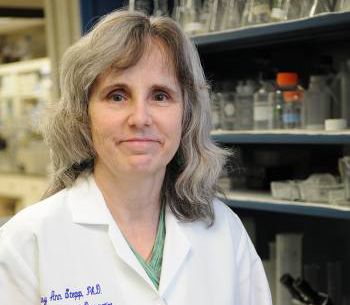
Dr. Stepp attended Simmons College in Boston, MA majoring in chemistry and nutrition. She conducted research as an undergraduate with Rena Mendelsohn, PhD and Agnes M. Huber, PhD at the Harvard School of Public Health in Boston on the role of trace elements in the development of fetal alcohol syndrome and became interested in nutritional biochemistry. After graduating, she enrolled in Boston University’s Interdepartmental Biochemistry PhD program at the BU School of Medicine. She obtained her PhD in Biochemistry working with Dr. Gail Sonenshein on translational control of the regulation of collagen synthesis in aortic smooth muscle cells. During this time, she began to develop a keen and lasting interest in the role played by cell matrix in regulating protein synthesis in cells.
With her graduate work complete, in fall 1985, she began postdoctoral work at the Massachusetts Institute of Technology at the Cancer Center with Dr. Richard O. Hynes, the same year that Dr. Hyne’s lab reported the discovery of the first “integrin”. Integrins are a large family of cell surface receptors that bind the extracellular matrix and are expressed on all cell surfaces. It was an honor to be working in the Hynes Lab at the beginning of the characterization of a family of proteins that would go on to show important roles in cardiovascular disease, immunology, and cancer biology. After two years of post-doctoral work identifying and cloning what turned out to be α3 and α4 integrins, Dr. Stepp left MIT for Harvard and the Schepen’s Eye Research Institute in Boston where she continued to study cell matrix adhesion and learned about the cornea as a model system for the study of cell adhesion. By studying the cornea and it’s integrins, insights into the cell biology of adhesion could be learned and applied to real life problems that impact the quality of life of patients.
In 1992, Dr. Stepp moved her lab from Boston to the Department of Biochemistry at GWU Medical School; in 1994, she became a Research Assistant Professor in the Anatomy Department and promoted to Professor in 2004.
Since integrins were first described in 1985 until now, Dr. Stepp has been studying how cells interact with their extracellular matrix environment to mediate cell proliferation, differentiation, and migration in response to injury using the skin and cornea as model systems. The cornea is the most highly innervated epithelial surface in the body. The Stepp Lab is now looking at how epithelial adhesion to axons is modulated during wound healing, with aging, and in dry eye disease.
Dr. Stepp has published over 50 scientific articles, served on several scientific advisory boards, and currently is on the editorial board of Experimental Eye Research. Dr. Stepp has received numerous grants for her research over the years from the National Institute of Health. She was made a Gold Fellow of the Association for Research In Vision and Ophthalmology (ARVO) in 2011 and awarded the Distinguished Researcher award from GWUMC.